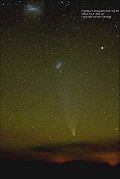| |
Summary:
Comet McNaught swung by the Sun in mid-January
2007. Fierce solar heat turned it into the brightest comet in 40
years; for a few days it was actually visible in broad daylight!
When McNaught emerged from the sun's glare into the skies of the
Southern Hemisphere, the tail alone stopped traffic and was mistaken
for a brush fire, an explosion, a mysterious cloud and probably
many other things never reported. For photographers, it was the
photo-op of a lifetime. Now Comet NcNaught is receding into the
outer solar system never to return -- only the pictures remain. Enjoy
the gallery! |
 |
| |
| |
Photographer,
Location |
Images |
Comments |
|

|
Gordon
Garradd,
Siding Spring Observatory, NSW Australia
Feb. 9, 2007 |
#1,
more |
Comet
McNaught continues to display over 15 degrees of tail to
the naked eye now the moon is out of the way.
Photo
details: Nikon
D200, ISO 320, 500 seconds |
|

|
Ian
Cooper,
Glen Oroua, Manawatu, New Zealand
Feb. 8, 2007 |
#1 |
People
have been calling me and saying that they are having trouble
seeing THE comet, mostly city folk. Well at 4th magnitude
it is probably not surprising. Then again, what they didn't
know is that I have captured McNaught down my chimney!
Photo
details: Nikon F with a 50mm
lens at f/2, 60 second exposure on Fuji Xtra 800 film.
|
|

|
George
Ionas,
Opiki, New Zealand
Feb. 8, 2007 |
#1 |
High
altitude hazy cloud hampered a good view of comet McNaught
but it was still visible to the unaided eye. This three
minute guided exposure shows comet McNaught with an approximate
8 degree tail and exhibiting a small but distinct anti-tail.
Photo
details: Nikon
D100, ISO800, 105mm
lens, f/1.8, 180 second exposure. |
|

|
Chris
Picking,
Wairarapa, North Island, New Zealand
Feb. 8, 2007 |
#1,
more |
Taken
around 11pm local time, this image shows the comet with
the Large and Small Magellanic clouds above.
Photo
details: Canon
10D, ISO800, 18mm
lens, f/3.5, 5 minute exposure. |
|

|
Daniel
Bedo,
The Pinnacles in the Nambung National Park near Cervantes,
about 250 Km North of Perth Western Australia
Jan. 29, 2007 |
#1 |
The
lack of light from development made for excellent viewing
conditions in this unique location.
Photo
details: Nikon
D200, 50mm
lens, f 8, 800 ISO, 30 sec exposure, fill in flash for
foreground. |
|

|
Stephane Guisard,
Above Santiago de Chile in the Andes, 13000 feet altitude.
Jan. 21, 2007 |
#1,
more |
Photo
details: Canon
20Da, 21
mm lens, f/4, 30sec exposure, 400 asa
|
|
|
|